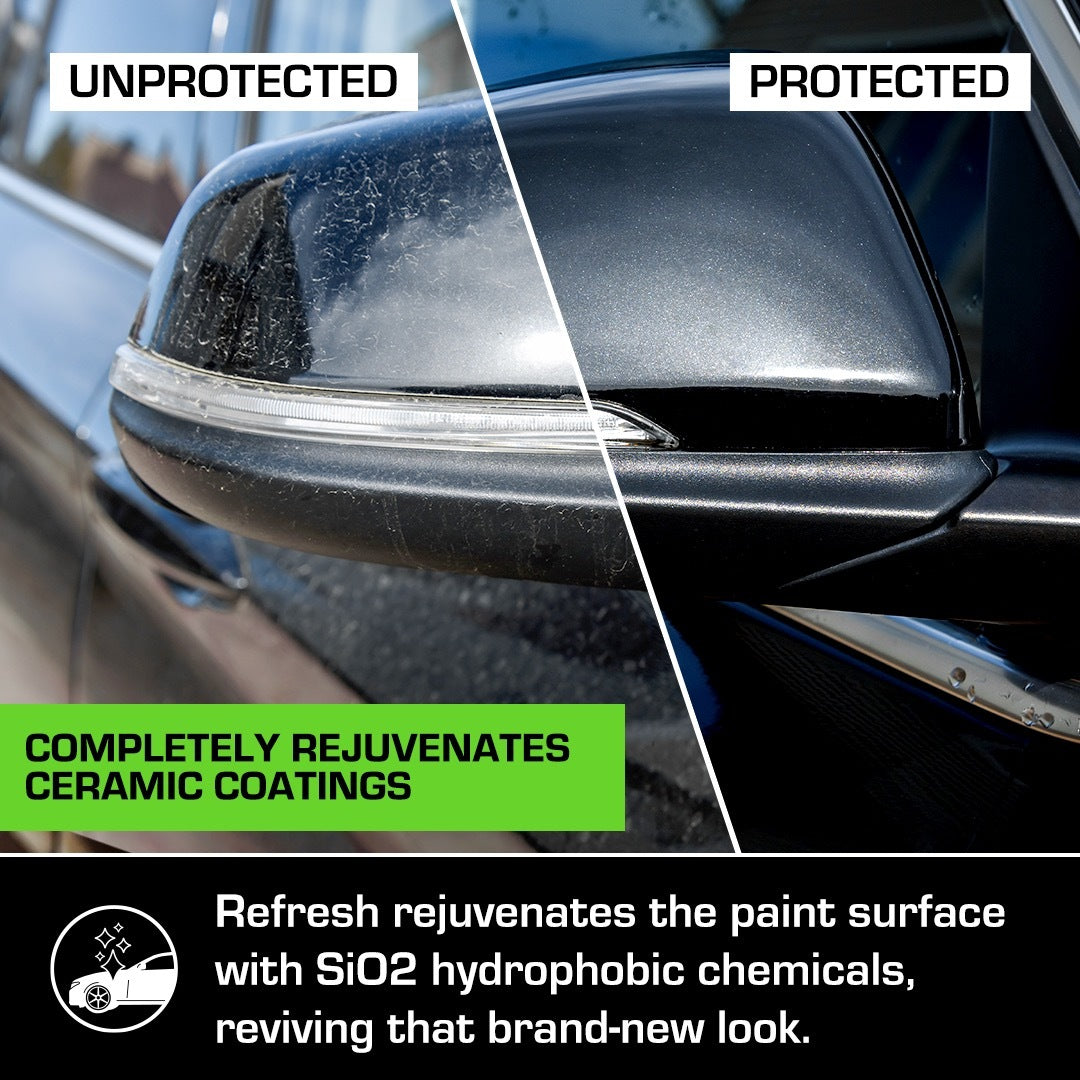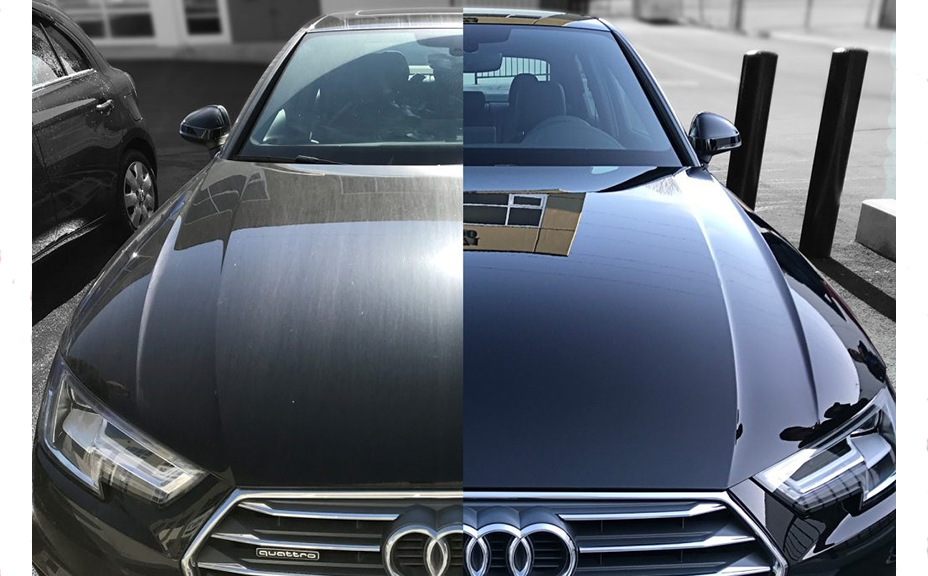All you need to know about Ceramic Coating Newark before you book
Wiki Article
Discovering the Scientific Research Behind Car Ceramic Coating and Its Protective Residences
The scientific research of car ceramic coating presents a remarkable study in sophisticated automobile security. Composed primarily of silicon dioxide and polymers, these finishings form a durable bond with car paint. This interaction boosts sturdiness versus ecological risks while using hydrophobic benefits. The details of how these finishings job and their lasting benefits stay much less understood. Ceramic Coating Newark. Unboxing these details exposes why ceramic finishes are coming to be a favored option for vehicle treatmentWhat Is Ceramic Coating?
Ceramic coating is a fluid polymer that chemically bonds to the surface area of a lorry's paint. This advanced safety layer boosts durability and uses premium resistance to ecological aspects. Unlike traditional wax or sealants, which give momentary defense, ceramic finishes produce a long-lasting shield that can stand up to rough conditions such as UV rays, acidic contaminants, and extreme climate. When used correctly, the coating creates a hydrophobic surface, creating water to bead and slide off, which aids in preserving the automobile's tidiness. In addition, it supplies improved gloss and deepness to the paint, making the lorry show up even more refined and vivid. The application process generally involves complete surface preparation, consisting of cleansing and polishing, to guarantee peak bonding. Therefore, ceramic layers are coming to be progressively prominent amongst car lovers and those seeking to shield their investments, guaranteeing to preserve the lorry's visual allure while reducing the regularity of maintenance.The Structure of Ceramic Coatings
The detailed formulation of ceramic coverings largely contains silicon dioxide (SiO2), which is originated from all-natural sources like quartz and sand. This essential element supplies the structure for the coating's resilience and protective high qualities. In addition to SiO2, ceramic finishings usually include numerous polymers and additives that improve bond, flexibility, and resistance to ecological elements. These substances work synergistically to produce a robust barrier against contaminants such as dirt, chemicals, and UV rays.Furthermore, some formulas include titanium dioxide (TiO2) or other nanomaterials, which can increase the coating's hydrophobic residential properties, resulting in enhanced water repellency. The exact structure can vary substantially among makers, influencing performance and durability. Eventually, the mix of these components culminates in a protective layer that not just boosts the aesthetic allure of cars but likewise serves to lengthen their life expectancy by securing the surface area from prospective damages.Just How Ceramic Coatings Work
Understanding exactly how ceramic layers function includes exploring their chemical make-up, which adds to their safety high qualities. The application procedure is vital for achieving suitable outcomes, while longevity and durability aspects establish the coating's efficiency over time. With each other, these aspects highlight the advantages and efficiency of ceramic coverings for lorry defense.Chemical Make-up Explained
While many car proprietors seek resilient security for their lorries, the chemical make-up of ceramic coatings plays a critical function in their effectiveness. These finishings primarily contain silicon dioxide (SiO2), which is originated from natural minerals. This substance creates a strong bond with the vehicle's paint, developing a resilient, safety layer. In addition, numerous ceramic layers include titanium dioxide (TiO2), improving their hydrophobic residential or commercial properties and resistance to UV rays. The existence of polysiloxanes can further boost versatility and sturdiness. Together, these aspects contribute to the coating's capability to push back water, dirt, and pollutants, while likewise providing a high-gloss surface. Recognizing this chemical structure helps car owners value the durable security provided by ceramic coverings.Application Process Overview
Applying ceramic coverings entails a thorough process that guarantees optimal bonding and protection for the car's surface area. Originally, complete cleaning and decontamination of the car's outside are carried out to eliminate dirt, gunk, and previous waxes. This step validates that the surface is without impurities that might prevent adhesion. Following this, the paint is often brightened to enhance clarity and remove any type of imperfections. Once prepared, the ceramic coating is used in little areas using an applicator pad, enabling uniform insurance coverage. The coating is then entrusted to cure, developing a solid chemical bond with the surface. Correct treating times and conditions are critical, as they confirm the coating accomplishes its optimum performance and safety top qualities.Durability and Durability Elements
Ceramic finishes are developed to supply long-lasting protection through their advanced chemical make-up, which creates a durable barrier against ecological impurities. The longevity of these finishings is influenced by factors such as the thickness of the application, the quality of the product, and the conditions under which the car is exposed. High-grade ceramic layers can last a number of years, withstanding scratches, UV rays, and chemical discolorations. Correct maintenance, including regular washing and periodic reapplication, can additionally boost long life. In addition, ecological elements like climate and exposure to toxins can impact the life expectancy of the coating. In general, when applied and preserved appropriately, ceramic finishings offer phenomenal sturdiness, making them find this a popular option for car lovers looking for to maintain their lorry's appearance.Hydrophobic Characteristics and Water Repellency
Hydrophobic residential or commercial properties are a trademark of top quality car ceramic coverings, considerably enhancing the lorry's surface area efficiency. These finishes create a molecular bond with the car's paint, leading to a surface that wards off water successfully. When water comes right into contact with a ceramic-coated surface, it beads up and rolls off, minimizing the amount of fluid that stays on the paint. This habits not just adds to a visually pleasing look however additionally minimizes the buildup of impurities such as dirt, crud, and road salts.The boosted water repellency causes simpler cleaning and upkeep, as less initiative is required to get rid of unwanted materials. In enhancement, the hydrophobic nature of ceramic coverings helps in stopping water places, which can mar the surface of uncoated surfaces. In general, the unification of hydrophobic residential properties in ceramic finishings plays an essential function in maintaining the lorry's pristine appearance while simplifying upkeep.Protection Versus Scratches and UV Damages
Car ceramic finishings provide considerable defense versus scratches and UV damage. The scratch resistance device develops a long lasting layer that absorbs impacts, while the UV securing advantages aid keep the lorry's paint honesty with time. With each other, these functions add to a longer-lasting and visually attractive finish.Scratch Resistance Device
Using innovative innovation, ceramic coverings give a robust guard against scrapes and UV damage, boosting the durability and appearance of lorry surface areas. The scratch resistance device of these layers is credited to their distinct molecular framework, which forms a resilient bond with the vehicle's paint. This bond develops a hard, protective layer that can take Check This Out in influences and resist abrasions. In addition, the smooth surface of the coating minimizes friction, making it challenging for contaminants to adhere and create scrapes. The chemical structure of ceramic coverings usually consists of nanoparticles that strengthen the protective layer, further boosting its resilience. Consequently, cars treated with ceramic finishes show considerably boosted scrape resistance compared to standard wax or sealers, guaranteeing an excellent coating in time.UV Shielding Conveniences
The safety qualities of ceramic coverings extend beyond scratch resistance to include substantial UV protecting benefits. These finishes produce a durable obstacle that mirrors dangerous ultraviolet rays, guarding the automobile's paint and underlying products. Extended direct exposure to UV radiation can bring about fading, oxidation, and deterioration of the paint coating. By including ceramic finishes, car owners can successfully reduce these risks, protecting the visual charm and honesty of their vehicles. Additionally, the UV obstructing properties add to improved longevity, lowering the regularity of repainting and upkeep. Eventually, the integration of ceramic layers uses an extensive remedy for shielding automobiles from the destructive results of sunlight exposure, guaranteeing a sustained, dynamic appearance gradually.The Longevity and Maintenance of Ceramic Coatings

Often Asked Concerns
Can Porcelain Coating Be Applied to Any Type Of Kind Of Vehicle?
Ceramic coating can be put on various kinds of automobiles, consisting of cars, trucks, and motorcycles. However, surface area prep work and compatibility with certain materials are necessary for excellent adhesion and effectiveness of the coating.How Much Does Ceramic Coating Normally Cost?
Ceramic coating normally costs between $500 and $2,000, depending upon elements such as lorry size, coating quality, and specialist application. The investment can supply durable defense and boost the lorry's look gradually.
Is Expert Application Needed for Finest Results?
The necessity of specialist application commonly relies on desired results. Experts generally guarantee correct surface area preparation and application strategies, causing excellent bonding and durability of the coating, which may be challenging for unskilled people to achieve.Can Ceramic Coatings Be Gotten Rid Of or Repaired?
Ceramic coverings can be gotten rid of or repaired, though the procedure might call for certain solvents or strategies - Ceramic Coating Newark. Appropriate removal is important to stay clear of damages to the underlying surface, stressing the importance of specialist support for optimal resultsExactly How Does Ceramic Coating Contrast to Traditional Wax?
The contrast between ceramic coating and standard wax reveals that ceramic finishings offer remarkable sturdiness, enhanced security versus ecological contaminants, and longer-lasting luster, while wax needs extra frequent application and offers less total resistance to damages.Report this wiki page